- Sorry, this product is unavailable.
-
 A fascinating history of Christmas carols and their meanings. Who was Good King Wenceslas? What are the pagan origins of The Holly And The Ivy? And - of course - what was the partridge doing in the pear tree? Carols first appeared in the Middle Ages, when a carol was any song sung with the singer standing in a circle; they were banned under Puritan law and united the soldiers on both sides on the Western front; and they are the longest running tradition of Christmas.
A fascinating history of Christmas carols and their meanings. Who was Good King Wenceslas? What are the pagan origins of The Holly And The Ivy? And - of course - what was the partridge doing in the pear tree? Carols first appeared in the Middle Ages, when a carol was any song sung with the singer standing in a circle; they were banned under Puritan law and united the soldiers on both sides on the Western front; and they are the longest running tradition of Christmas. -
 What's in a name? Well, plenty, according to this interesting little booklet. The word 'dunce' meaning slow-witted or dull is from the name Duns Scotus, a brilliant medieval teacher; Dick Whittington, mayor of London, did exist but is not the legendary poor boy with a pet cat seeking his fortune; Robert Louis Stevenson's infamous character Dr. Jekyll was based on a real man; Old 'Uncle Tom Cobbleigh' was a hotblooded and amorous red-headed man; Lady Godiva did get her gear off as a result of a bet with her husband - and Mother Goose did write a swag of nursery rhymes! Loads of interest in a small package.
What's in a name? Well, plenty, according to this interesting little booklet. The word 'dunce' meaning slow-witted or dull is from the name Duns Scotus, a brilliant medieval teacher; Dick Whittington, mayor of London, did exist but is not the legendary poor boy with a pet cat seeking his fortune; Robert Louis Stevenson's infamous character Dr. Jekyll was based on a real man; Old 'Uncle Tom Cobbleigh' was a hotblooded and amorous red-headed man; Lady Godiva did get her gear off as a result of a bet with her husband - and Mother Goose did write a swag of nursery rhymes! Loads of interest in a small package. -
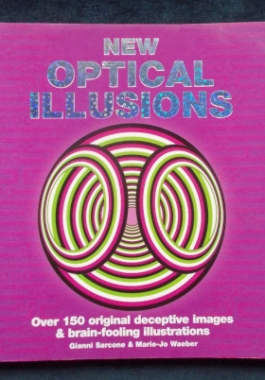 Over 150 original images guaranteed to cross your eyes, baffle your brain and frustrate your friends - there's even one dated from the time of the Ancient Romans. In colour and black and white.
Over 150 original images guaranteed to cross your eyes, baffle your brain and frustrate your friends - there's even one dated from the time of the Ancient Romans. In colour and black and white. -
 Inimitable (definition): that which defies imitation. For years, Mikes wrote witty articles and books on every aspect of British life, pricking pomposity and praising decency. Contains chapters on how to avoid travelling, wine snobbery, television, how to be class conscious and how to remain poor. Mikes may have emigrated from Hungary - but he wouldn't live anywhere else. Illustrated by Nicholas Bentley.
Inimitable (definition): that which defies imitation. For years, Mikes wrote witty articles and books on every aspect of British life, pricking pomposity and praising decency. Contains chapters on how to avoid travelling, wine snobbery, television, how to be class conscious and how to remain poor. Mikes may have emigrated from Hungary - but he wouldn't live anywhere else. Illustrated by Nicholas Bentley. -

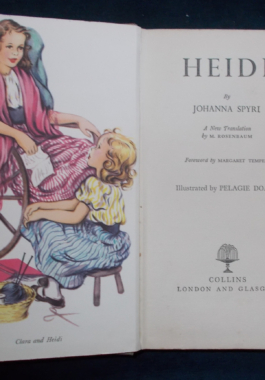
Heidi: Johanna Spyri
$9.00First published in 1880, here is Heidi's story - a young Swiss girl whose parents' sudden death leaves her to be brought up by her Aunt Dete - a hard-working woman who loves Heidi, but does not have the time or resources to look after a child in busy Frankfurt. She leaves Heidi with Heidi's grandfather, who lives in the Swiss mountains. The lonely, embittered old man lives like a hermit on the mountain-top and has nothing to do with the people in the village below. Known to all as “Alm-uncle”, Heidi's grandfather is good-hearted but mistrustful of the villagers. He refuses to send Heidi to school and allows her to roam the pastures with a mischeivous young goat herder, Peter. They become good friends but events take a turn when Aunt Dete decides that Heidi must stay in Frankfurt and learn to earn a living as a companion to a rich invalid child, Clara, and soon learns to read and write along with the little girl. The city begins to take its toll on the young Heidi and she becomes ill and depressed, longing for the open spaces. How Heidi returns to her beloved mountains, reforms her crotchety old grandfather and helps Clara regain her health forms the rest of this perennial classic. With illustrations in colour and black and white by Pelagie Doane. -

 Young student Axel and Professor Otto Lidenbrock, studying a very old manuscript, discover an ancient pathway into the centre of the Earth. They travel to Iceland, and with the assistance of Hans, a local guide, they find an entrance in Snæfellsjökull, a volcano near Reykjavík. The travel is extensively long, and not without its many perils. Will they be able to make it? And what amazing wonders await hidden within the depths of the Earth? Colour illustrations by T.C. Dugdale.
Young student Axel and Professor Otto Lidenbrock, studying a very old manuscript, discover an ancient pathway into the centre of the Earth. They travel to Iceland, and with the assistance of Hans, a local guide, they find an entrance in Snæfellsjökull, a volcano near Reykjavík. The travel is extensively long, and not without its many perils. Will they be able to make it? And what amazing wonders await hidden within the depths of the Earth? Colour illustrations by T.C. Dugdale. -
 Jerusha Abbott is the oldest orphan in the John Grier Home. When her future is discussed, one of the Trustees offers to finance her through college so that she can become a writer. The conditions: she must write to him once a month and tell him of her progress and she can only know him as Mr John Smith as he wishes his identity to remain a secret. Jerusha - now called Judy - names him Daddy-Long-Legs because her single glimpse of his shadow reminds her of a spider. Here are Judy's college days letters to 'Daddy-Long-Legs.' Cover art from a photograph by Houston Rogers showing actress Jean Carson as Judy in the play Love from Judy based on the book.
Jerusha Abbott is the oldest orphan in the John Grier Home. When her future is discussed, one of the Trustees offers to finance her through college so that she can become a writer. The conditions: she must write to him once a month and tell him of her progress and she can only know him as Mr John Smith as he wishes his identity to remain a secret. Jerusha - now called Judy - names him Daddy-Long-Legs because her single glimpse of his shadow reminds her of a spider. Here are Judy's college days letters to 'Daddy-Long-Legs.' Cover art from a photograph by Houston Rogers showing actress Jean Carson as Judy in the play Love from Judy based on the book. -
 The sequel to The L-Shaped Room. Jane has had her baby and is living alone with him in the country cottage she inherited from her late, non-conformist Aunt Addy. Her idyllic time there is soon complicated by the arrival of Toby, the love of her life, and her friend Dorothy. The two women start up a shop in the village, and it is their changing fortunes and feelings for the men on whom so much of their lives are staked which form the core of this novel. Readers new to this author will find it dated - The L-Shaped Room was written and set in the early 60s, when cultural and societal beliefs about many things, including single mothers, were vastly different. But kept in context, both books, together with the third, Two Is Lonely, can form a very interesting and educational trio of life in the 60s.
The sequel to The L-Shaped Room. Jane has had her baby and is living alone with him in the country cottage she inherited from her late, non-conformist Aunt Addy. Her idyllic time there is soon complicated by the arrival of Toby, the love of her life, and her friend Dorothy. The two women start up a shop in the village, and it is their changing fortunes and feelings for the men on whom so much of their lives are staked which form the core of this novel. Readers new to this author will find it dated - The L-Shaped Room was written and set in the early 60s, when cultural and societal beliefs about many things, including single mothers, were vastly different. But kept in context, both books, together with the third, Two Is Lonely, can form a very interesting and educational trio of life in the 60s. -
 Hundreds of hopefuls congregate at a cattle call for Broadway dancers. Sour director, Zach and his brusque assistant whittle down the ranks until they're left with 16 dancers. Each one has a story - some are tragic, some are comic - and explain their love of dance. Tension mounts when Cassie - once both a big star and the director's lover but now desperate for a part - auditions. But Zach must choose only the best for his show. Musical.
Hundreds of hopefuls congregate at a cattle call for Broadway dancers. Sour director, Zach and his brusque assistant whittle down the ranks until they're left with 16 dancers. Each one has a story - some are tragic, some are comic - and explain their love of dance. Tension mounts when Cassie - once both a big star and the director's lover but now desperate for a part - auditions. But Zach must choose only the best for his show. Musical. -
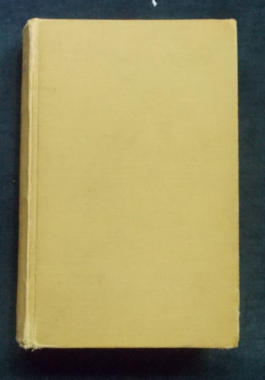
 Esquire's selection of the alumni of literature. These anthologies are becoming scarce, so if you are the type of reader who likes to have everything your favourite author wrote, don't delay! In this volume: Sweet Faces and Foul Minds, George Jean Nathan; Washing the Hands, Aiken A. Dehan; Latins Are Lousy Lovers, Helen Brown Noren; The Wench Is Not Amused, Anonymous; Essay on Jiggling, George A. McNamara; A Report On Man's Best Friend, Lawrence Martin; Christ in Concrete, Pietro di Donato; They Order It Better In France, Anonymous; No More Trouble For Jedwick, Louis Paul; The Beaut From Montana, Frank Scully ; Gold Star Mother, Philip Stevenson; A Good Job Gone, Langston Hughes; What I Am Faithful To My Wife, Thames Williamson; A Breast Of The Times, Herb Graffis; After Baby Comes, Douglass Welch; I Mix The Drinks, W.B. Lytton; Cafeteria Complex, Fred S. Tobey; The Martyr, Newman Levy; Don't Laugh Now, J.C. Furnas; You Can't Sleep With Women, Alan MacDonald; Yonder's Henry! Thorne Smith; Keeping Cool At Conneaut, Paul Gallico; The Resurrection of Solly Moon, Walter D. Edmonds; Greek Tragedy, Ring Lardner; I Drink American and Take Along The Little Pal! Donald Hough; The Snows of Kilimanjaro and On The Blue Water, Ernest Hemingway; Uncle Fonse Laughed, Jesse Stuart; A Duel by Candlelight, Andreas Latzko; The Tall Coorter, Sean O'Faolain; But For This...Lajos Zilahy; A Shot In The Forest, Felix Salten; The Night Before Chancellorsville, F. Scott Fitzgerald; A Place To Lay One's Head, Waldo Frank; The Kid Across the River, William McFee; The Lonesome Vigilante, The Ears of Johnny Bear and A Snake of One's Own, John Steinbeck; You, The Phantom, Theodore Dreiser; Snowfall in Childhood, Ben Hecht; The Seven Men of Rouen, George Slocombe; Black Tobias And The Empire, Heinz Werner; The Five-Pengö Girl, Sandor Hunyady; Never Comes Monday, Eric Knight; The Girl From The River Barge, Walter Schoenstedt; The Whole World Is Outside, Manuel Komroff; August Afternoon, Erskine Caldwell; The Euthanasian Garden, Havelock Ellis; The Art Of Understanding Women, W. Béran Wolfe, M.D.; Queen In The Parlour Car, Joseph E. McDougall; Are Wrestlers People? Westbrook Pegler; Hide Your Eyes and The Old School Tie, Edward Acheson; A Shipment of Mute Fate, Martin Storm; An Idea For A Story, André Maurois; So Smells Defeat, George Antheil; Three Dead Geese, Vincent Sheean; Token Of Esteem, Harlan Ware; Pim and Pooh, Ferdinand Czernin; The Monument, Irwin Shaw; Deutchsland Über Alles, J.L. Campbell; The Bronze Baffler, Hart Stilwell; An Adventureee Retires, Hilaire du Berrier; The Scent of Fear, Jack Melville; Three Skeleton Key, George C. Toudouze; Leningen Versus The Ants, Carl Stephenson.
Esquire's selection of the alumni of literature. These anthologies are becoming scarce, so if you are the type of reader who likes to have everything your favourite author wrote, don't delay! In this volume: Sweet Faces and Foul Minds, George Jean Nathan; Washing the Hands, Aiken A. Dehan; Latins Are Lousy Lovers, Helen Brown Noren; The Wench Is Not Amused, Anonymous; Essay on Jiggling, George A. McNamara; A Report On Man's Best Friend, Lawrence Martin; Christ in Concrete, Pietro di Donato; They Order It Better In France, Anonymous; No More Trouble For Jedwick, Louis Paul; The Beaut From Montana, Frank Scully ; Gold Star Mother, Philip Stevenson; A Good Job Gone, Langston Hughes; What I Am Faithful To My Wife, Thames Williamson; A Breast Of The Times, Herb Graffis; After Baby Comes, Douglass Welch; I Mix The Drinks, W.B. Lytton; Cafeteria Complex, Fred S. Tobey; The Martyr, Newman Levy; Don't Laugh Now, J.C. Furnas; You Can't Sleep With Women, Alan MacDonald; Yonder's Henry! Thorne Smith; Keeping Cool At Conneaut, Paul Gallico; The Resurrection of Solly Moon, Walter D. Edmonds; Greek Tragedy, Ring Lardner; I Drink American and Take Along The Little Pal! Donald Hough; The Snows of Kilimanjaro and On The Blue Water, Ernest Hemingway; Uncle Fonse Laughed, Jesse Stuart; A Duel by Candlelight, Andreas Latzko; The Tall Coorter, Sean O'Faolain; But For This...Lajos Zilahy; A Shot In The Forest, Felix Salten; The Night Before Chancellorsville, F. Scott Fitzgerald; A Place To Lay One's Head, Waldo Frank; The Kid Across the River, William McFee; The Lonesome Vigilante, The Ears of Johnny Bear and A Snake of One's Own, John Steinbeck; You, The Phantom, Theodore Dreiser; Snowfall in Childhood, Ben Hecht; The Seven Men of Rouen, George Slocombe; Black Tobias And The Empire, Heinz Werner; The Five-Pengö Girl, Sandor Hunyady; Never Comes Monday, Eric Knight; The Girl From The River Barge, Walter Schoenstedt; The Whole World Is Outside, Manuel Komroff; August Afternoon, Erskine Caldwell; The Euthanasian Garden, Havelock Ellis; The Art Of Understanding Women, W. Béran Wolfe, M.D.; Queen In The Parlour Car, Joseph E. McDougall; Are Wrestlers People? Westbrook Pegler; Hide Your Eyes and The Old School Tie, Edward Acheson; A Shipment of Mute Fate, Martin Storm; An Idea For A Story, André Maurois; So Smells Defeat, George Antheil; Three Dead Geese, Vincent Sheean; Token Of Esteem, Harlan Ware; Pim and Pooh, Ferdinand Czernin; The Monument, Irwin Shaw; Deutchsland Über Alles, J.L. Campbell; The Bronze Baffler, Hart Stilwell; An Adventureee Retires, Hilaire du Berrier; The Scent of Fear, Jack Melville; Three Skeleton Key, George C. Toudouze; Leningen Versus The Ants, Carl Stephenson. -
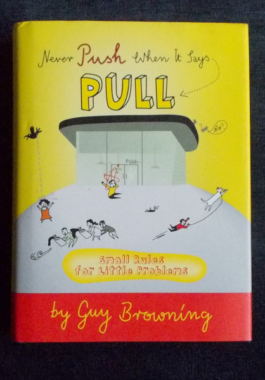 How to survive minor social embarrassments - and somewhat reminiscent of The Grumpy Old Men television series! Have you ever queued, exasperated by the repeated cry of 'Next!' and asked the man in front, 'Are you deaf?' only to discover that he is? Who hasn't tried to slip under the covers before the lover of their dreams discovers they're wearing chewing-gum-grey undies? If you have, then Guy Browning is here with an invaluable guide to surviving such toe-curling moments. His advice includes: What to do when you discover the man you beeped, flashed and swore at for driving too slowly is your girlfriend's father who you'll meet for the first time that night. How to convince your friends that shoes with loo-paper attached to the soles are now a cutting-edge fashion statement. How to argue, persuasively, that George Eliot is in fact a man. Also included: how to use a library; how to push a shopping trolley; how to shop by catalogue and how to exaggerate.
How to survive minor social embarrassments - and somewhat reminiscent of The Grumpy Old Men television series! Have you ever queued, exasperated by the repeated cry of 'Next!' and asked the man in front, 'Are you deaf?' only to discover that he is? Who hasn't tried to slip under the covers before the lover of their dreams discovers they're wearing chewing-gum-grey undies? If you have, then Guy Browning is here with an invaluable guide to surviving such toe-curling moments. His advice includes: What to do when you discover the man you beeped, flashed and swore at for driving too slowly is your girlfriend's father who you'll meet for the first time that night. How to convince your friends that shoes with loo-paper attached to the soles are now a cutting-edge fashion statement. How to argue, persuasively, that George Eliot is in fact a man. Also included: how to use a library; how to push a shopping trolley; how to shop by catalogue and how to exaggerate. -
 The plays of Noel 'The Master' Coward still draw audiences today. This is a compilation of the Mermaid Theatre's Cowardy Custard which brought together the best of Noel Coward, as well as some of his less well-known songs and poems. Beautifully illustrated with colour and black and white drawings and photos.
The plays of Noel 'The Master' Coward still draw audiences today. This is a compilation of the Mermaid Theatre's Cowardy Custard which brought together the best of Noel Coward, as well as some of his less well-known songs and poems. Beautifully illustrated with colour and black and white drawings and photos. -
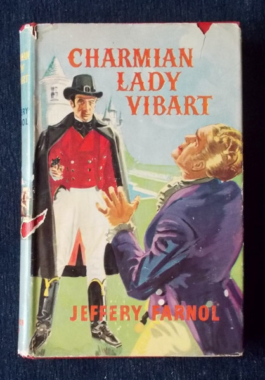
The sequel to The Broad Highway. This is the story of the fiery Charmian's love for her husband and reckless son - and the passion her beauty arouses in two ruthless men. Charmian, now in her forties and a great deal more wary and wise, is still a great beauty and not afraid to gamble life and honor in a sinister and perilous game. While in Paris, young Richard Vibart, son of Sir Peter and Lady Charmian, receives a challenge from Henri Willoughby-Gafton, a famous duelist whom Richard has slapped for speaking lightly of Lady Charmian. When Sir Peter hears of it he hurries to Paris, while Charmian - with a plan of her own - follows secretly. But is Henri Willoughby-Gafton the real villain? Mr. Bob Meadows, the valet from The Broad Highway also makes a reappearance. Set during the Regency.
-

The Bondman: Hall Caine
$10.00First published in the late 1890s, this is the tale of half-brothers Michael and Jason. Jason is sworn to avenge the wrongs done to their father; Michael is sworn to rectify them. The story moves from the Isle of Man to Iceland. On the way the half brothers encounter love, personal upheaval, political revolutions and natural disasters. This is not only a literal journey - it is also a spiritual journey. -
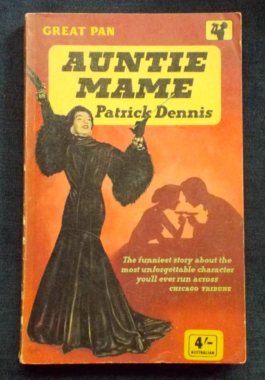
Auntie Mame: Patrick Dennis
$10.00The madcap story of Patrick's adoption at the age of ten by his zany, unconventional Auntie Mame. And life with Auntie Mame was never ever dull! Sparklingly witty, irreverently satirical, this 1955 novel manages to remain timelessly relevant in its cutting send-up of conformity and conservatism. Patrick reminisces his way through life with Mame in the glittering Roaring Twenties, surviving the Great Depression, her marriage and widowhood, World War II and into his first forays into romance. Based on a real Aunt. Cover shows Rosalind Russell in the 1958 film of the same name. -

Pale Rider: Alan Dean Foster
$10.00A nameless stranger rides into the corrupt and explosive gold-rush town of Lahood, California. His arrival coincides with the prayer of a young girl who is hoping for a miracle to end the sudden and random violence in the community. Fifteen year-old Megan quietly recites from the Bible: "And I looked, and beheld a pale horse: and his name that sat on him was Death and Hell followed with him.' A story of confrontation in a lawless time, the nameless stranger becomes a catalyst for hope and retribution. A struggle between ruthless corporation gunmen and innocent independent miners takes on a new meaning with the appearance of the enigmatic horseman... A novelisation based the screenplay of the film Pale Rider by Michael Butler and Dennis Shryack. Follows the film almost exactly. The book contains stills from the film. -
 Welcome to the world of Art Handel, a world where the unexpected and expected often collide with the absolutely and totally unexpected and with little regard for each other. While it's sometimes nice to see how the other half live, this book gives you an insight into how the other half of that other half live. Described as 'dark and enlightening, horrific and hilarious...funny stuff emerges from the damndest places...like a clown with a razor blade...startling...original and darkly gleeful...think Stephen King on laughing gas...'
Welcome to the world of Art Handel, a world where the unexpected and expected often collide with the absolutely and totally unexpected and with little regard for each other. While it's sometimes nice to see how the other half live, this book gives you an insight into how the other half of that other half live. Described as 'dark and enlightening, horrific and hilarious...funny stuff emerges from the damndest places...like a clown with a razor blade...startling...original and darkly gleeful...think Stephen King on laughing gas...' -
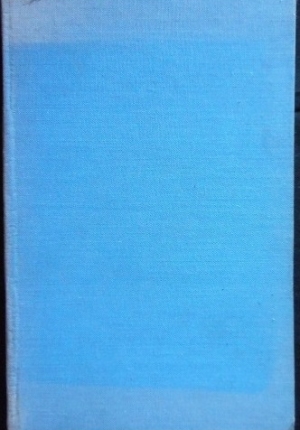
 Set in an orphanage founded by an archbishop, the story opens on the No 14 bus trundling through London. The reader is given the background on most of the bus passengers - shadowy figures that play but a brief role - save one. A young woman who leaves the bus and disappears into the fog to the orphanage where she leaves a warmly wrapped baby on the doorstep. She kisses the child and leaves and all that is left is this new born child with a label attached to the shawl saying "Sweetie". And so Sweetie's life in St Mark's Orphanage begins. It is not a harsh, Dickensian place - the children are well cared for and it is run by Canon Mallow, sweet-natured, kind and slightly inept. He loves all the children but he is soon to retire and his place is taken by a new appointee, Dr Samuel Trump who is determined that St Mark's will be run efficiently - on proper lines - and he is appalled at the inefficiency and disorganisation he sees before him. Sweetie and Ginger, a real holy terror, strike up a friendship. Ginger is always up to all sorts of mischief and tricks who even manages to climb over the wall at night and go 'up West' on forays into the big wide world. He is the bane of Dr Trump's life as no amount of punishment or detentions seem to have any effect on him whatsoever and Sweetie, who has an adventurous streak in her as well, causes a lot of upset for the new Warden. https://cosmiccauldronbooks.com.au/p/london-belongs-to-me-norman-collins-2/
Set in an orphanage founded by an archbishop, the story opens on the No 14 bus trundling through London. The reader is given the background on most of the bus passengers - shadowy figures that play but a brief role - save one. A young woman who leaves the bus and disappears into the fog to the orphanage where she leaves a warmly wrapped baby on the doorstep. She kisses the child and leaves and all that is left is this new born child with a label attached to the shawl saying "Sweetie". And so Sweetie's life in St Mark's Orphanage begins. It is not a harsh, Dickensian place - the children are well cared for and it is run by Canon Mallow, sweet-natured, kind and slightly inept. He loves all the children but he is soon to retire and his place is taken by a new appointee, Dr Samuel Trump who is determined that St Mark's will be run efficiently - on proper lines - and he is appalled at the inefficiency and disorganisation he sees before him. Sweetie and Ginger, a real holy terror, strike up a friendship. Ginger is always up to all sorts of mischief and tricks who even manages to climb over the wall at night and go 'up West' on forays into the big wide world. He is the bane of Dr Trump's life as no amount of punishment or detentions seem to have any effect on him whatsoever and Sweetie, who has an adventurous streak in her as well, causes a lot of upset for the new Warden. https://cosmiccauldronbooks.com.au/p/london-belongs-to-me-norman-collins-2/


